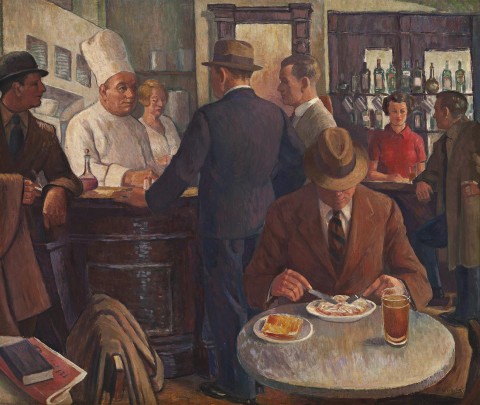HOTEL SCENE, c.1950
ROLAND WAKELIN
oil on canvas
102.5 x 121.0 cm
signed and dated indistinctly lower right: R. Wakelin / 5 (ind.)
Private collection
Sotheby's, Melbourne, 19 August 1996, lot 226
Private collection, Sydney
Roland Wakelin was an artist who delighted in depicting the everyday. A devoted family man, his subjects included his wife and children, augmented by views sourced from locations near to his home and work. From the 1930s to the 1950s, the Wakelins lived in a variety of flats and houses in North Sydney, Waverton and Potts Point, all suburbs with proximity to the harbour’s foreshore. Having survived the financial precariousness of the Great Depression, Wakelin never under-estimated the necessity of paid employment and spent many years working for O’Brien Publicity at their substantial offices near Circular Quay. This left the weekends free for painting, a task he dedicated himself to and through which he created a fascinating painterly record of the changing landscape of the city and its people. From the 1950s, Wakelin painted regularly in the company of John Santry, George Lawrence and Lloyd Rees, all of whom lived nearby. Together they would walk the foreshore finding suitable locations to paint, before discussing each other’s work afterwards over a relaxed picnic.
The setting for Hotel Scene, c.1950, still feels familiar today. In a bustling urban pub, a businessman sits eating a modest lunch, schooner of beer to one side and buttered toast on the other. Like three of the other male customers, he still wears his hat, coat and tie, and the number of overcoats indicates that the weather is chilly outside. To the left, the pub’s chef engages in a conversation whilst two modestly attired barmaids tend to their duties. Intriguingly, it appears that the central character is eating a bowl of spaghetti, a then relatively new taste sensation for the average Australian given impetus by the post-war emigration of many Italians and other Europeans. The fact he attempts to do so using a knife and fork is part of the common cultural collisions of the decade, memorably portrayed by Nino Culotta (John O’Grady) in his book They’re a Weird Mob (1957).1
Wakelin’s use of rich, sonorous colours in Hotel Scene enhances his depiction of the warmth of the pub’s interior, and the easy camaraderie of its clientele. Unlike other artists such as James Wigley and John Perceval who preferred to depict the raucously undignified atmosphere of the notorious ‘six o’clock swill’, Wakelin reveals a less critical view of humanity. It was an attitude he shared with that other great chronicler of Sydney, Herbert Badham, whose Oxford Street Interior, 1942 (State Library of New South Wales, Sydney) is a prime example. Like Badham, Wakelin doesn’t patronise or sentimentalise his subjects, he simply catches them as they are, with affection and the keen interest of an artist’s eye, creating lasting images of ‘remarkable solidity and depth (in which) each object in a scene, through a concentration of its essential elements, becomes a forceful and individual entity in the general ensemble’.2 Three decades after his debut as one of this country’s modernist precursors, Wakelin’s Hotel Scene is the work of a man content with life and full of generosity towards others, but one underpinned by many years of painterly practice, all of which combine to the benefit of this quintessentially Australian interior scene.
The author thanks fashion historian Nicole Jenkins for assistance in analysing this work.
1. For example, in July 1952, The Australian Women’s Weekly published their first ever recipe for Spaghetti Bolognese. A key ingredient was Worcester Sauce. The author thanks Kelly McLean for this information.
2. Wilkinson, K., ‘Roland Wakelin’, Art in Australia, third series, no. 56, August 1934, p. 29
ANDREW GAYNOR
